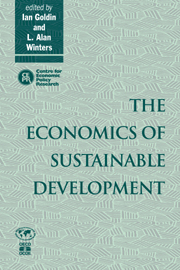Book contents
- Frontmatter
- Contents
- List of figures
- List of tables
- Preface
- Acknowledgements
- List of conference participants
- 1 Economic policies for sustainable development
- PART ONE GROWTH AND THE ENVIRONMENT
- 2 Pollution and growth: what do we know?
- Discussion
- 3 Does sustainability require growth?
- Discussion
- PART TWO SUSTAINABILITY
- PART THREE DOMESTIC POLICY
- PART FOUR INTERNATIONAL POLICY COORDINATION
- Index
2 - Pollution and growth: what do we know?
Published online by Cambridge University Press: 04 August 2010
- Frontmatter
- Contents
- List of figures
- List of tables
- Preface
- Acknowledgements
- List of conference participants
- 1 Economic policies for sustainable development
- PART ONE GROWTH AND THE ENVIRONMENT
- 2 Pollution and growth: what do we know?
- Discussion
- 3 Does sustainability require growth?
- Discussion
- PART TWO SUSTAINABILITY
- PART THREE DOMESTIC POLICY
- PART FOUR INTERNATIONAL POLICY COORDINATION
- Index
Summary
There is growing concern that continued expansion of the world economy will cause irreparable damage to the earth's environment and a reduced quality of life for future generations. This fear rests on two intuitive notions: first, that more output requires more inputs and so the earth's ‘sources’ (of natural resources) inevitably will be depleted by continued growth of production and consumption; and second, that more output means more emissions and wastes, and so the earth's ‘sinks’ inevitably will become overburdened by continued economic growth. Those who are most alarmed by this scenario see the possibility that economic activity will eventually exceed the ‘carrying capacity’ of the biosphere (see, e.g. Daly, 1977), with dire consequences for human and animal welfare. To avoid such a tragic outcome, they argue, it is necessary for global economic expansion to cease and for humankind to make the transition to a steady-state economy.
Others have noted that the scale of economic activity is but one determinant of the rate of depletion of natural resources and the rate of production of waste materials and gases (see, e.g. World Bank, 1992; Radetzki, 1992). Equally important are the composition of economic output and the techniques used to produce it. If, along with economic growth, there comes a transformation in the structure of the world economy, as well as the substitution of cleaner and resource-conserving technologies for dirtier, resource-using technologies, then growth can continue to provide ever higher standards of material living without threatening the nonmaterial aspects of human wellbeing.
- Type
- Chapter
- Information
- The Economics of Sustainable Development , pp. 19 - 46Publisher: Cambridge University PressPrint publication year: 1995
- 81
- Cited by



